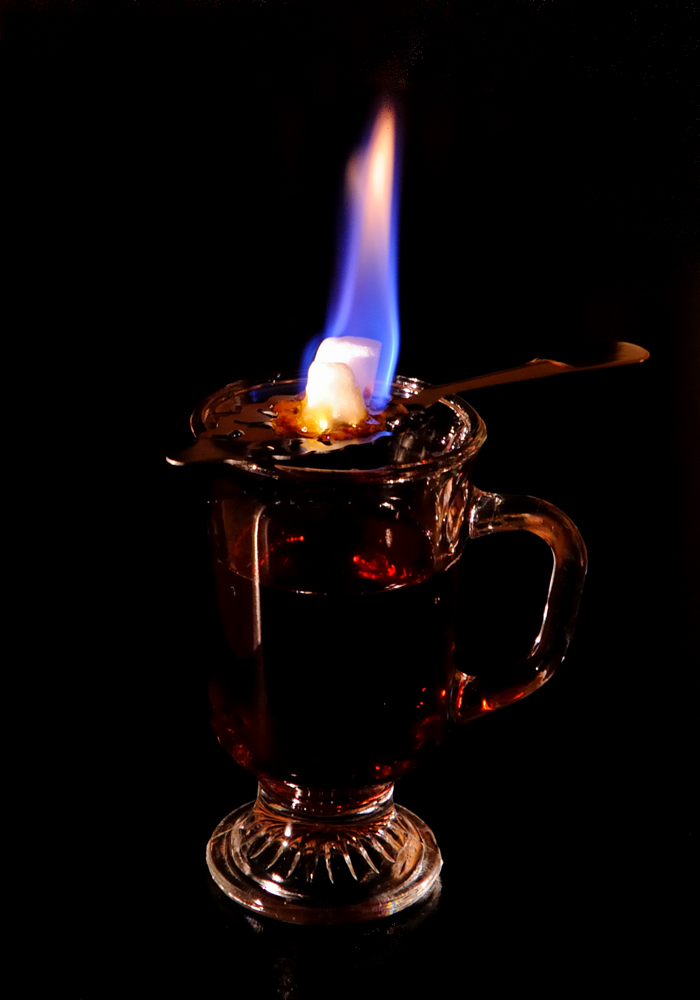
As winter stubbornly clings to our shores, I continue my exploration of the delightful realm of hot mulled wines and other soul-warming beverages.
Feuerzangenbowle stands as a captivating jewel among traditional German drinks, stemming from the heartwarming concept of gluhwein, the beloved hot mulled wine. Mulled wine enjoys immense popularity in Germany, especially during the frigid winter season. Yet, the human spirit is naturally inclined to infuse life with novelty and brilliance. This very urge brought Feuerzangenbowle into existence. Its preparation is simple, yet the results are utterly captivating, especially the visual spectacle it creates. All it requires is a batch of hot mulled wine, a sugar cone drenched in high-proof rum, and a touch of fire. As the rum ignites, the sugar melts, caramelizes, and gracefully drips into the wine. When the entire sugar cone has dissolved into the wine, the punch is ready for service. The caramelized sugar adds a unique flavor dimension to the punch, yet the true essence of Feuerzangenbowle lies in its fiery show. Historically, a set of fire tongs, reminiscent of its literal meaning, “fire-tong punch,” was used to position the sugar cone above the wine.
Feuerzangenbowle boasts a rich history that dates back to the mid-18th century, finding an ardent following among German students. Try to pronounce the name of this drink out loud. Not the simplest task, is it? Now, envision yourself as a jovially inebriated student and give it another try. Impossible, you say? Well, that’s precisely what students of the time encountered. However, their vocal struggles found a creative solution. They affectionately bestowed the name “Krambambouli” upon Feuerzangenbowle. In fact, this moniker was a catch-all term for any red and robust spirits, including Feuerzangenbowle. In truth, students’ propensity for brevity and humor led them to appropriate this term. Krambambouli refers to a cherry liquor produced by the Der Larch distillery in Danzig (present-day Gdansk). This distillery, established by Dutch Mennonite Ambrosius Vermollen at the close of the 16th century, enjoyed significant popularity until the early 20th century when it ceased operations.
Feuerzangenbowle stands as a captivating jeweKrambambouli, with its humorous and accessible name, began to replace Feuerzangenbowle in student circles, becoming synonymous with the burning mulled wine. Students even composed a song in honor of Krambambouli, led by Christoph Friedrich Wedekind in 1745. This catchy tune found favor among students and became a spirited anthem. You can listen to it here. The page features both the German lyrics and an English translation.
Belarusians couldn’t resist borrowing the name “Krambambouli” either, giving it a local twist – Krambambula. In Belarus, it refers to vodka infused with honey and spices.
Returning to Germany and Feuerzangenbowle, it was the goodwill of German students that ultimately led to “Feuerzangenbowle” and “Krambambouli” becoming synonymous terms for most people in the mid-19th century. However, the official name remains Feuerzangenbowle.
Feuerzangenbowle is typically enjoyed during the Christmas season, with many Christmas markets eagerly serving this spectacular drink.
The modern resurgence of Feuerzangenbowle in Germany can be traced back to the release of the 1944 film “Die Feuerzangenbowle,” an adaptation of Heinrich Spoerl’s novel. The opening scene of this delightful novel unfolds around a bowl of Feuerzangenbowle. Although multiple cinematic versions of the book exist, it is the 1944 rendition that has become an enduring part of Christmas entertainment to this day. Of course, watching the movie typically goes hand in hand with sipping on a cup of Feuerzangenbowle.
Let’s shift from history to the art of preparation.

While special sets designed for preparing Feuerzangenbowle are available (such as the one pictured), they’re not essential for the process. Any pot of sufficient volume and a suitable burner will suffice. Sugar tongs, although convenient (and available for separate purchase), can be replaced with items on hand, even historic fire tongs, to add a touch of tradition to the experience.
If you’re preparing Feuerzangenbowle for just yourself or one other person, you can even make it directly in the serving cup, provided you have a small pot to prepare the mulled wine. In such cases, even a fork can serve as makeshift sugar tongs. I used an absinthe spoon, which proves quite handy.
Now, let’s gather the ingredients for your mulled wine. You can find the mulled wine recipe in this my artickle. To closely mimic the German variant, include orange, cinnamon, cloves, star anise, and cardamom in your spices. You may want to reduce the sugar quantity as well. Once you’ve prepared your mulled wine, set it above the burner.
Position your sugar tongs (or their substitute) above a pan or glass.
Place the sugar cone on the sugar tongs, aiming for 45 to 75 grams of sugar per bottle of wine.
Now, soak the sugar with rum. It’s important to note that the rum must be at least 54% ABV to burn properly. I used 75% ABV. There are many high-proof rums available on the market; just be sure to choose one that meets this criterion. Carefully drizzle the rum over the sugar, ideally using a spoon, and then ignite it. Don’t forget to extinguish the flames to appreciate the mesmerizing effect of the burning sugar.
Should the rum burn out while some sugar remains on the tongs, simply repeat the soaking and burning process.
Once the sugar cone has completely melted into the wine, your punch is ready. Savor the moment, and enjoy your Feuerzangenbowle!
Visit my online store for a unique poster featuring this cocktail, along with many other beautiful cocktails and other wine-related subjects.
It’s the perfect way to add a touch of sophistication to your kitchen or bar. Click here to shop now!